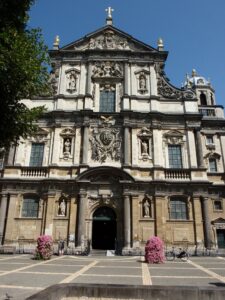Hendrik Conscienceplein: St. Charles Borromeo's Church
The reverend prior of the Society of Jesus in Antwerp, Jacobus TIrinus, requests the honourable Peter Paul Rubens and his fellow, the honourable Anthony van Dijck, both artist-painters and Masters of St. Luke’s Guild in Antwerp, that they should paint him thirty-six ceiling paintings and three altarpieces to serve as decoration of (St. Charles Borromeo) church within the city.
We cherish our heritage more and more. But we usually disregard the fact that in our historical buildings such as our monumental churches, different styles of the past have been mixed together.
That is definitely not the case here: this temple, together with the surrounding square, is a harmonious work of Baroque elegancy. This can be explained: the church had a short construction time (1615-1621), and it was inspired by the Rome model of the Gesù church.
Our Baroque artists were consciously taking a step forward in art history; they developed further the vision of the Renaissance, by paying renewed attention to man and his anatomy, to his ideas (humanism) and to nature (perspective).
Already in the first sentence of his introduction to ‘Palazzi di Genova’, Rubens talked about mediaeval architecture in a condescending way:
Al benigno lettore : Vediamo che in queste parti, si và poco à poco inuecchiando & abolendo la maniera d’Architectura, che si chiama Barbara, ò Gothica, …
“Dear reader: We have seen that in these regions, the architectural style called Barbaric or Gothic is gradually changing and disappearing. Persons with good taste are introducing, to the great honour and beautification of the country, the style of construction which shows true symmetry and which conforms to the laws laid down by the Greeks and Romans. We see examples of this in the splendid churches which the venerable Society of Jesus has just erected in Brussels and Antwerp.”
The façade, the interior and especially the Lady Chapel still give us a sense of how the Jesuits as patrons and Rubens, amongst others, as a virtuoso performer, created an impressive whole. It is an interplay of art forms in which the sculptures and ornaments take a step forward out of the shadow of the niches. The tangible abundance of materials was meant to make us feel the spiritual riches of faith: a life beyond every day’s isolated existence, but included in a joyful community.
The Jesuits also used the Word in their preaching, but they knew how to illustrate it with image. In this way they appealed to both reason and emotion. The spectator had to be drawn into the depicted scene and become a participant in the religious representation.
In this church, Rubens is present with a smaller work (the ‘Return of the Holy Family’) and a copy of one of his versions of the ‘Assumption of Mary’. Below this painting, Mary’s life is depicted, in a small format, by Hendrick van Balen.
Anthony Van Dyck was also mentioned by name in the agreement with the Jesuits; but there are only few traces of him left here, because of the fire on July 18, 1718. This destroyed 39 ceiling paintings, made by Rubens and van Dyck in cooperation. Today, it is with mirrors and reproductions of the oil sketches that we should get a suggestion of what this ceiling decoration once looked like.
Opposite this church, in what is now the Heritage Library, meetings were held between lay associations and the Jesuits; in this way the religious order kept the intelligentsia ‘on their toes’. Anthony van Dyck painted two works for his own section there, called the Youngsters-of-Age/Bejaerde Jongmans, the unmarried male adults. For both paintings he didn’t charge full market price. But you have to go to foreign museums to see them today because, when the Jesuit order was dissolved, their possessions were sold and scattered. In this way they still serve as our art ambassadors.


